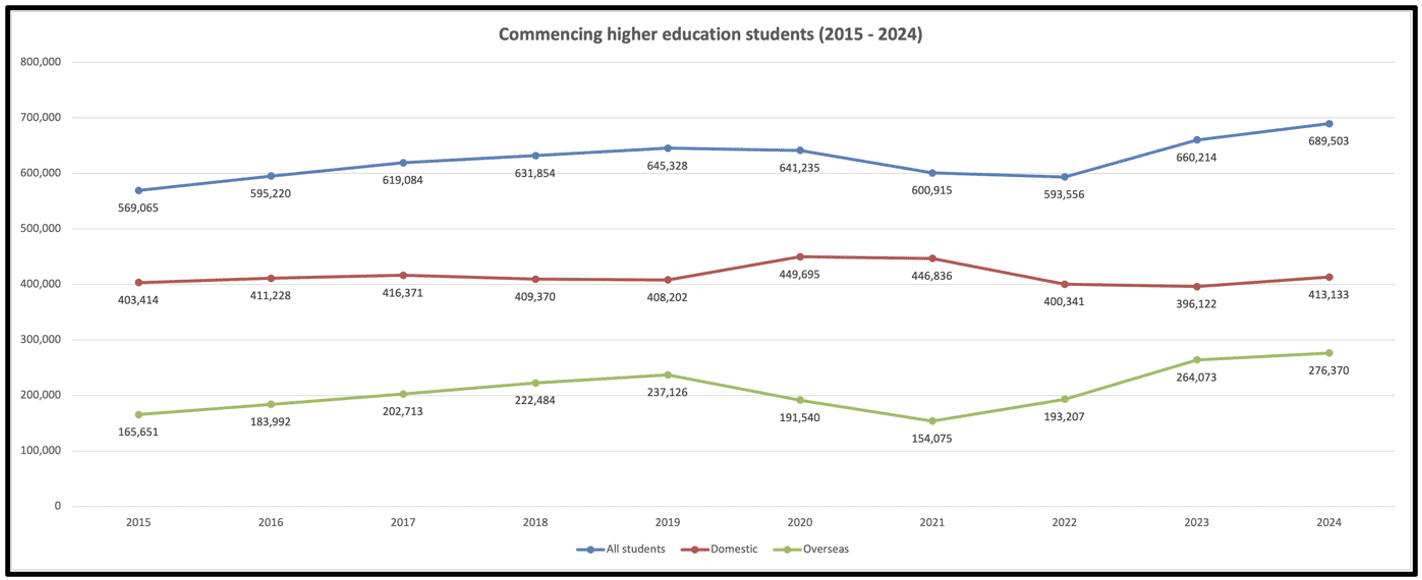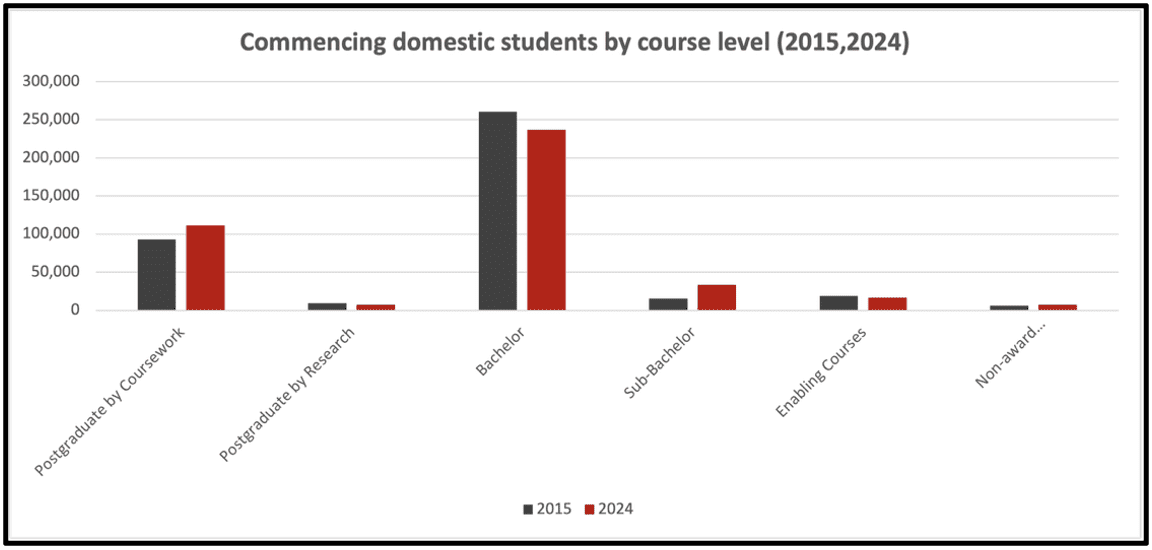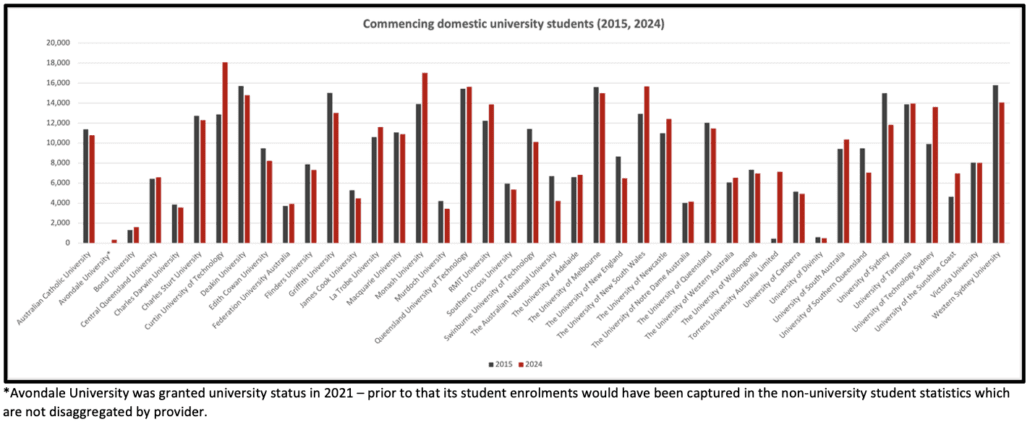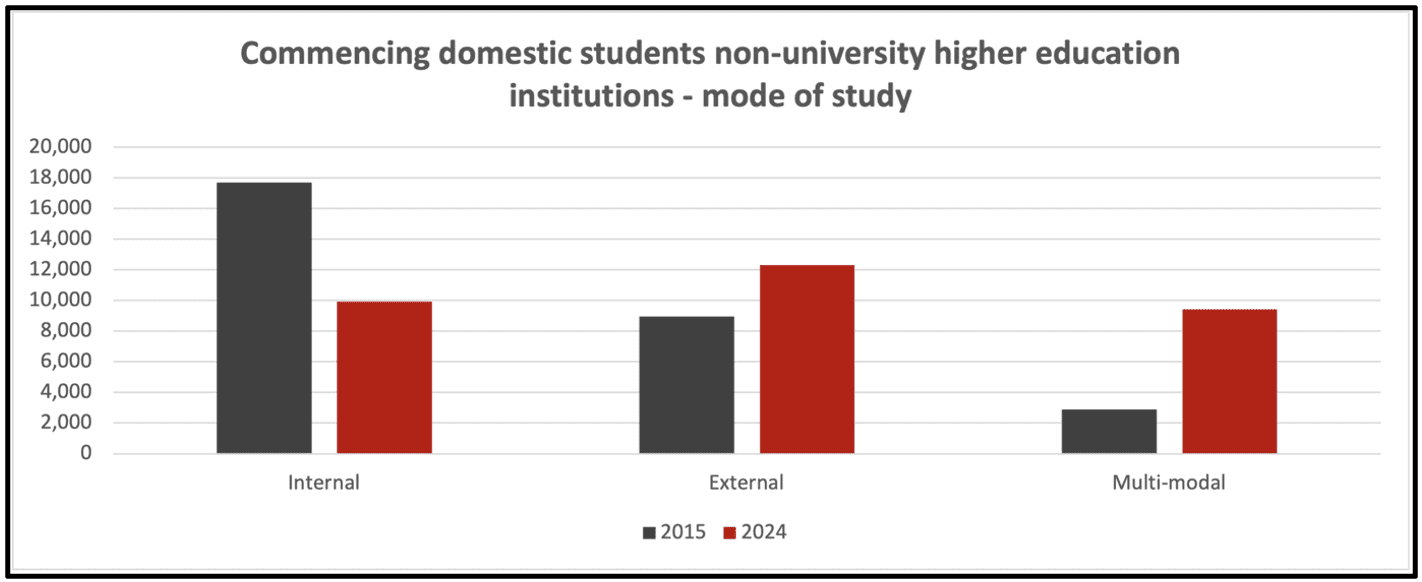
Higher education 2024: which students enrolled where?
In the last fortnight we have seen the release of the full student datasets for higher education and VET.
In two updates I have looked at a key cohort in each sector.
In the higher education sector I have chosen to focus on domestic commencing students – as the government prepares to make changes to attract more new students into higher education following the recommendations of the Universities Accord panel.
In a related report on the VET sector, although there are a lot of VET enrolments in single subject courses (eg first aid) and this is legitimate and important VET delivery, I have chosen to focus my analysis on VET program enrolments (ie enrolments in full qualifications and skillsets) as it allows for more useful comparisons across key provider types, training packages and jurisdictions.
Higher education
Turning here to higher education and looked at over the past decade – there has been minimal growth in domestic commencing students in Australian higher education (2%), growth in commencing international students has been significant – up two-thirds in 2024 on 2015 figures (67%) meaning there has been an overall increase in commencing students since 2015 of 21%.

Most of the growth has been in postgraduate coursework programs (which have proven increasingly attractive to international students) and sub-bachelor programs (ie diplomas, advanced diplomas and associate degrees).

Looking at commencing students at each university between 2015 and 2024 shows some interesting patterns of growth and decline:


The universities with the highest levels of growth in commencing domestic students in the last decade are:
- Torrens University Australia (noting that the university only commenced operations in 2014) 1,450%
- University of the Sunshine Coast 50%
- Curtin University 40%
- UTS 37%
- Monash University 22%
- Bond University 22%
- UNSW 21%
- RMIT 13%
- University of Newcastle 13%
- University of South Australia 10%
The universities experiencing the highest levels of growth are predominantly based in the inner cities. Some of the University of Newcastle’s growth in commencing students is likely due to the success of their longstanding ‘Open Foundation’ enabling program, while the Sunshine Coast is a regional area experiencing high population growth which is likely a key contributor to the growth in commencing students at the University of the Sunshine Coast. Nevertheless better understanding the growth drivers at these two regional universities over the past decade will be of interest to other regional universities and presumably ATEC.
The universities which experienced the largest declines in commencing domestic students in the last decade were:
- ANU -37%
- USQ -26%
- UNE -25%
- University of Sydney -21%
- Murdoch University -18%
- University of Divinity -16%
- JCU -15%
- Griffith University -13%
- ECU -13%
- Swinburne University -11%
- WSU -11%
- Southern Cross University -10%
Most but not all of these universities experiencing declines are based in outer-metropolitan and regional areas. Interestingly two of the Group of Eight universities, the Australian National University and the University of Sydney, had large significant declines in their domestic enrolments over the last decade. The decline in enrolments at the ANU is in part due to its ‘on campus’ postgraduate offerings which no longer reflect the desire of many postgraduates to study online or in a blended mode, as I have written about previously. The University of Sydney’s decline is less readily explicable but with UNSW and UTS on the same bus route as the University of Sydney – it may be that the drivers attracting more commencing domestic students to UTS and UNSW have had a negative impact on student demand for the University of Sydney.
Changing modes of study
In 2015 the following nine universities had fewer than half of their commencing domestic students studying on campus ie most of their commencing domestic students were already studying online or ‘multi-modal’ (ie blended learning):
- The University of New England 9% of commencing domestic students studying on campus
- Charles Darwin University 13%
- Central Queensland University 13%
- Charles Sturt University 16%
- University of Southern Queensland 18%
- University of Tasmania 32%
- Southern Cross University 32%
- Swinburne University of Technology 36%
- La Trobe University 40%
By 2024 the shift away from predominantly on-campus study for domestic students was well underway as more universities offered more of their courses fully online or multi-modal, including:
- La Trobe University 0% (ie no commencing domestic students were fully on-campus – most, 70%, were ‘multi-modal’)
- The University of New England 4% on campus
- Torrens University Australia 5%
- University of Southern Queensland 6%
- Central Queensland University 7%
- University of Divinity 8%
- Charles Darwin University 10%
- University of South Australia 11%
- Griffith University 11%
- University of Tasmania 15%
- Monash University 17%
- Charles Sturt University 18%
- Southern Cross University 22%
- Deakin University 31%
- James Cook University 33%
- Swinburne University of Technology 36%
- University of Canberra 40%
- Edith Cowan University 40%
- Victoria University 44%
- Curtin University 44%
- Flinders University 45%
- Murdoch University 45%
Commencing domestic students at non-university higher education institutions[1]
In 2024, almost one in every ten (8%) domestic higher education commencing students (31,677) chose not to study at a university.[2] This was up 7% on the 29,599 domestic students choosing a non-university higher education institution in 2015.

The shift that non-university higher education institutions have made to offering more ‘external’ (ie online only) and multi-modal modes of study to their commencing domestic students over the last decade, as well as their abilities to grow their domestic student enrolments without public funding should be of interest to the publicly-funded university sector and to ATEC.
And with two-thirds (21,274) of all domestic commencing students in non-university higher education institutions studying with New South Wales based providers, sector leaders wanting to understand the growth in this part of the sector should be heading to Sydney to have those conversations.
Summary
Over the past decade, domestic commencing enrolments in Australian higher education have seen minimal growth (2%), while international commencements grew strongly by 67% compared with 2015, resulting in a 21% increase overall. Much of this expansion has been concentrated in postgraduate coursework and sub-bachelor programs.
Provider-level analysis highlights stark contrasts: inner-city universities such as UTS, UNSW, Monash, and RMIT expanded, while regional and outer-metropolitan universities such as USQ, UNE, Murdoch and JCU experienced significant declines. Interestingly, even Group of Eight members ANU (-37%) and the University of Sydney (-21%) recorded sizeable declines in their commencing domestic students, underscoring shifts in student demand, including preferences for blended or online postgraduate study.
The data also highlights the ongoing shift away from on-campus study. By 2024, universities such as La Trobe and UNE had fewer than 5% of their commencing domestic students studying fully on campus, reflecting broader growth in multi-modal and online provision.
Non-university higher education institutions have steadily grown their domestic market share, now enrolling nearly one in ten commencing domestic students (8%), without access to public funding. Concentrated particularly in New South Wales, these institutions’ ability to expand through online and blended delivery offers a competitive alternative to traditional universities, and their growth patterns deserve to be better understood by the sector and policymakers.
——————————
[1] Non-university higher education institutions include both university colleges and institutes of higher education
[2] When domestic students choosing to commence study at the four Table B ‘ie non-publicly funded’ universities (Avondale, Bond, Torrens, and University of Divinity) are included the total choosing alternatives to publicly-funded (Table A) universities is 41,237 of the 413,133 commencing domestic students ie 10%.
Disclosure – Claire is a PhD student at Torrens University Australia writing the history of the university’s first decade of operation.



